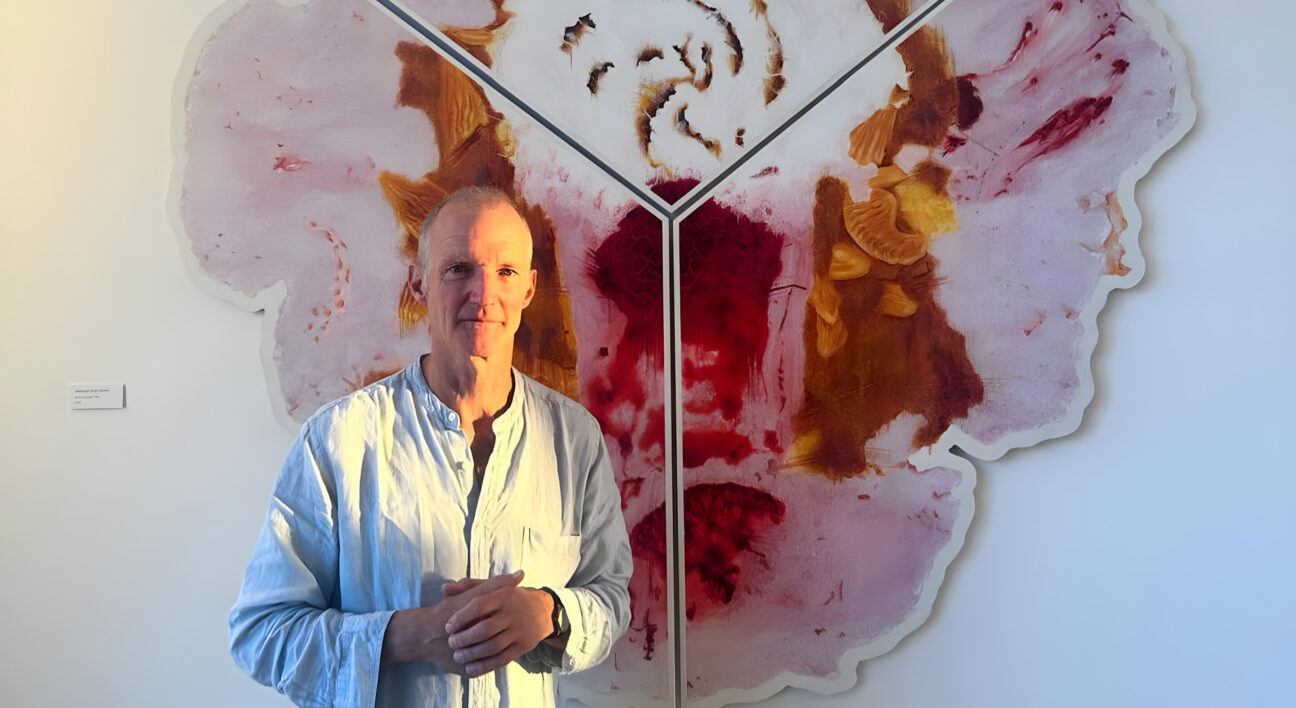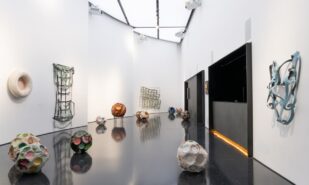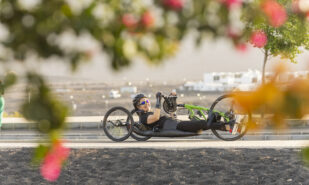While preparing for my interview with Anthony-Noel Kelly, which he had kindly agreed to do with London Cult in the light of his upcoming exhibition, What Lies Beneath, I found myself fascinated with him.
In Conversation with Anthony-Noel Kelly: The Present, the Past and the New
Like many other cultural hipsters who chase after artistic novelties in London as if it were a competitive sport, I find the works and the minds of controversial figures attractive for reasons similar to why an unsuccessful suitor proceeds with his affection after having been rejected – it is a desire to understand the new and unavailable unknown.
Throughout the 40 years of his career as a painter and sculptor, Anthony-Noel Kelly’s evolution as an artist has encompassed bold experiments, outrage, family dynamics, changing views of his models, inspiration from foreign countries and a deepening awareness of the world’s religious heritage. His is a journey that strikes the observer as personal and honest and real in its detachment from the digital buzz that has merged with modern art in the last decade.
This conversation took place in the Chelsea Arts Club, a notorious London private members’ club, where artists, writers, architects, musicians, filmmakers and everyone who matters seem to gather. Anthony knew almost everyone. We hid in the club’s garden marquee, emblazoned with the figures of dancing men and women, site of the club’s summer art balls. But summer was in the past and Anthony was in the present, so …
Anthony-Noel Kelly: Artists prefer to talk about their current work. Or the work they just finished. Past work is very much past. They’re not belittling work that they did but they, perhaps, lost the enthusiasm to describe it. It is the present and the future for me. One’s best work is the work you’re doing at the moment.
London Cult: Which leads to my first question – your current work. What are you working on right now?
A: Oh, nothing! Nothing!
[Laughs]
I think: What’s the point? Why do you work? I sometimes ask that question. You know, the existential question: Why are we here? I’m a little tired of working because I think one of the reasons for living is to share life. With somebody, with people, and I haven’t been sharing much – I’ve been working for myself. And it’s partly my fault. I don’t like to sell myself or change my work to suit others. I feel, almost, that I am not ready for this world – like when David Bowie says, ‘I am from another planet.’
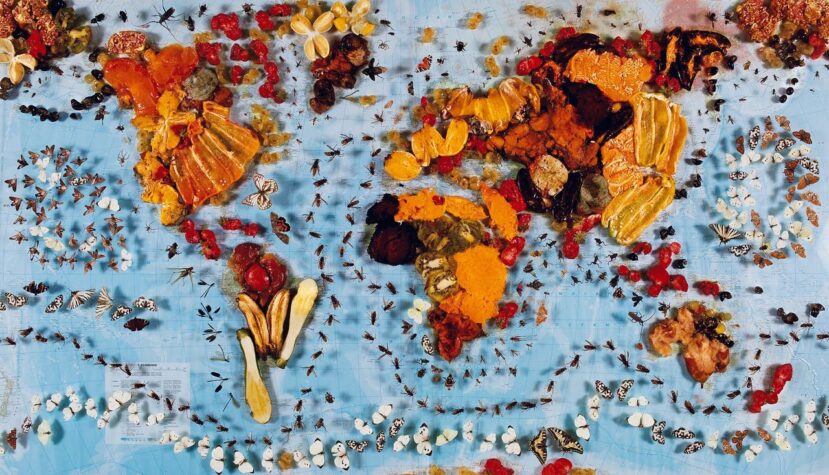
LC: Do you think art always has to have an audience?
A: Well, but we all do! Don’t you need an audience?
LC: Writing isn’t very solitary. It has to be read by someone.
A: But it’s more than that. An audience is important but my work is a journey of understanding. So when I paint it’s a way of educating myself. Because I have always done my own thing. I’ve always been doing my own projects. People say it’s easy but you need to have a break. To get up in the mornings and to be inspired and to be working – it’s not easy. The adrenaline has got to run.
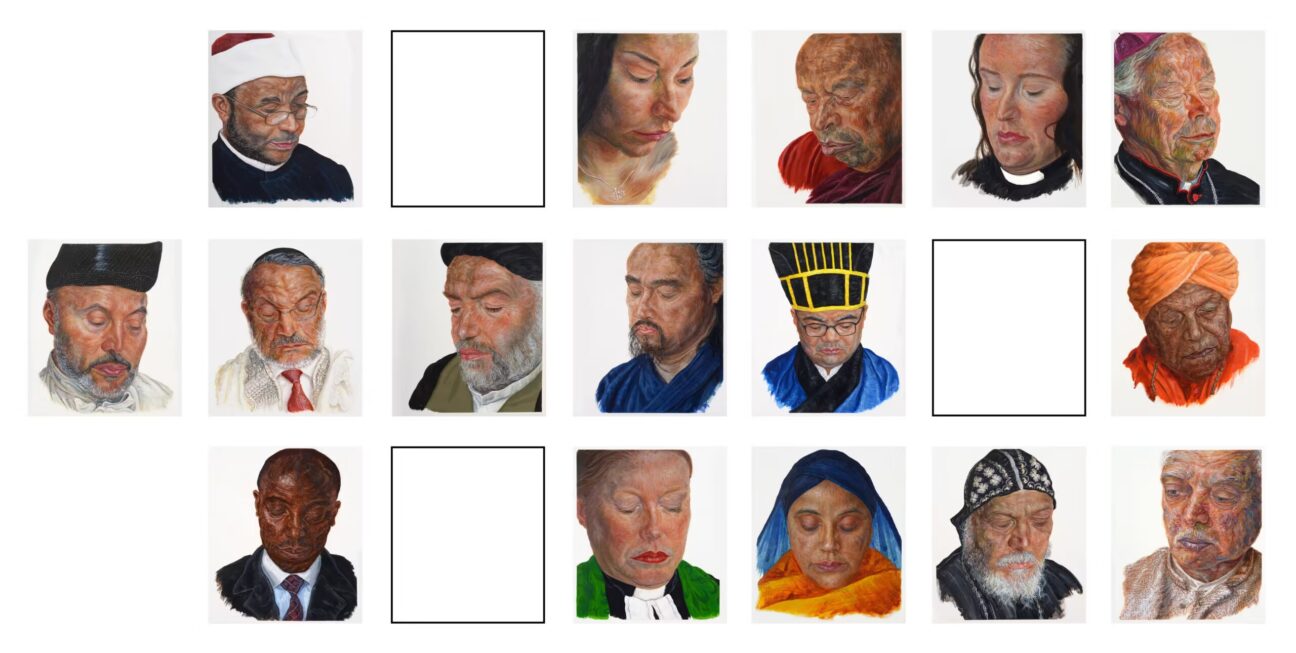
LC: Then what do you get inspired by?
A: Often, the visual part – say an orange or an animal – can inspire me because of the colour or the form. I use that as a kind of a pallet to express myself.
I’m just finishing documenting and photographing a really important piece of work. It’s important because it’s not about an artist expressing himself or herself. Us – humans – we do what we can – we create what we can from looking at the past and then using that as information to create something new.
But what I’ve been doing for the past fifteen years is collecting sacred texts from each global religion. Any religion that has over five million adherents is a religion for me to work with. There are about fifteen of these in the world. The largest are the Christians, and then there are the Jains, who are just over five million. I’ve been collecting such spiritual scriptures from each of these religions in different languages. For example, the Guru Granth Sahib from the Sikhs, the Torah, the Analects in Confucianism. The Dhammapada…
I stack them in columns – the smallest book goes on top and the largest below, and I put them one on top of the other. I’ve done them in different languages, so the Bible may be in English and the Quran may be in French.
I’ve done another column in different languages – the Quran may be in Japanese, for example – they’re living shelves. It’s also quite a dangerous thing to do. It can become sacrilegious when spiritual texts touch other texts. Because they’re different sizes, the larger goes below. I have the Quran next to the Torah – the sacrilegious do that. They are sacred objects and I put them together: they’re rubbing shoulders.
Religion plays a really large part in the way we live, so it’s not a work of art. It’s a reality, how we function, and that’s why I’m not the artist. These books are a reflection of who we are as humans – I find it inspiring.
I did it because it’s a celebration of human belief. Completely. Because you’ve got people who believe in religion, and then atheists, who don’t. One’s belief as an atheist is also important because that’s how one reasons. You don’t believe in God and therefore you do this and do that, and when you believe in God – it’s the same. It’s wonderfully reflective, it’s extraterrestrial, it’s as if the gods were hovering above our planet and seeing us fighting each other and loving each other. Although we have a limit – we are not perfect – we can show these beings above that we have a way of living, we have a respect for life.
LC: Is that related to the project you were doing – Ambassadors?
A: Yes. Ambassadors is… Well, I was talking to a Jain and he said, Why don’t you do portraits from each religion? So I’ve started. I did him first.
I had to go to China, to South Africa… I wanted to go to the Mormons – the last saints of America – because you can’t paint a Mormon, they won’t allow it. I’ve been to their headquarters in England and they said no. The other religion that you can’t paint is the Jehovah’s Witness.
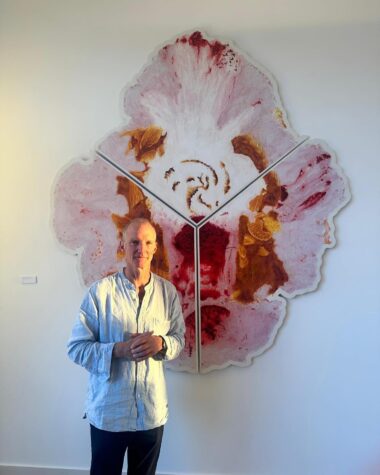
Besides them, there are two other outstanding religions – Shintoism and Atheism. There are no Shintoists in Europe because it’s not a religion in the sense that you go to a temple and meet each other. It’s a private thing, so you have your gods, your little spirits, and you pray to them – they’re by your bedside like in a theatre set. It’s a way of life. I have to find an atheist, too, and not just any atheist but an atheist that we all know.
LC: We started off by talking about the past and the present and the relationship between these two. I went over your work and there was a collection that didn’t have a name but it consisted of Irish landscapes painted in dark colours. I noticed that in your more recent work you used brighter, happy colours.
A: I wouldn’t say they’re happy colours. The 1980s, these dark landscapes … I was living in Ireland. They are just gestural. I showed them when I came back and got told by an artist that I should go to art school. They’re just full of emotions. I went around Wexford, looking at areas: a tree that was broken, a landscape with a cliff. They reflected how I felt at the time.
I painted a self-portrait with meat behind me once, tearful. I always had problems with backgrounds. You know you paint someone, the eyes, the mouth. You’ve done a portrait and you need a background. If you’re a sculptor your background is the world. With some portraits you use a bookcase or a landscape. I love meat, the incredible colours and the provenance of the various cuts. I painted the background of the self-portrait with meat, but I did it as if it was wallpaper. So these colours are very red, very blue. The colours are vibrant but it doesn’t necessarily mean that they are happy.
But really, I always preferred painting portraits of women. Because I just find this maternal softness in them. With men there is a lot of muscle and strength. In a woman’s body it’s different. So I’ve done lots of portraits of women but not in the conventional sense of faces and bodies. I’ve been taking parts of the body that represents woman. I paint parts. The eyes, the mouth, the ears. The bosoms – a door to yourself. I’ve had many models whose portraits I’ve done in many ways in different projects.
LC: Speaking of models. Your show in 1999, Birthdays, was a collection of photographs of women, men, dogs …
A: Dogs were actually in a different one, but Birthdays was males and females of every age from one-year-old up to a hundred. It took three years to complete. They have more of an importance than if I have portrayed them by painting. Because a photograph is quite real – there is very little subjectivity. All these people came to my studio and stood in the same place to be photographed.

My then-girlfriend, Claire, and friends accompanied me to nudist beaches and I advertised the project. My family also helped me in finding models. It was difficult to find people of every age.
But I would do anything for my work. When I have these projects I will go the full length, and I love a project that’s difficult. The more difficult, the more intriguing for me.
LC: What is the most difficult project you’ve done?
A: I’d like to think it’s a future project. I’m doing this work with fish. I’m going to Alghero in Sardinia to paint fish, and this project is going to be difficult because I’m not good at living away from England.
I’m trying to catch the spirit of the fish without actually depicting it as you see it. It won’t be a head and a tail and a body: it’s more that I’ll try to document what I see to catch the spirit through the internal physicalities.
LC: Japan could be a perfect place for catching spirits.
A: Yes? Well, I am free.
But I love Italy. I’ve been there for two years. Alghero has a port and there is a fish market for about two hours in the earlymorning. It’s perfect for my work.
LC: You’re not good at living away from England, what do you mean by that?
A: I need to have creature comforts. I’m terrible alone. I’m not good in my own company, especially in the evenings. When you eat, for example. I find that eating is to share, eating by yourself is just really weird. Because it’s a wonderful thing – eating food and conversing and sharing.
LC: Do you think that the modern world has become very antisocial?
A: It’s different but I can’t say that people are more lonely now. There are different ways of finding friends. But there’s a lot of competition, it’s more about how you look and how you promote yourself, your image and your Instagram. There’s a lot more pressure.
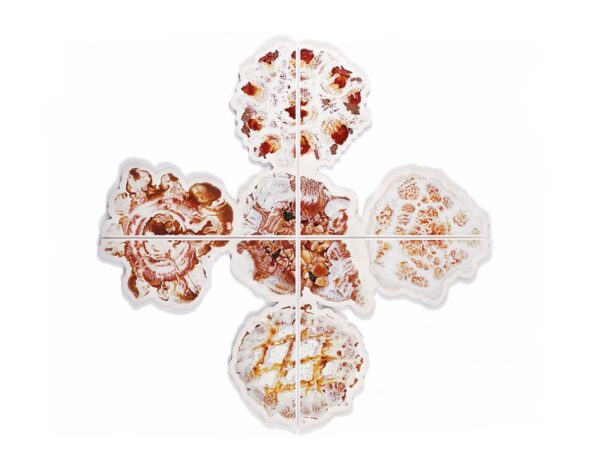
LC: Your exhibition in the 1990s caused a lot of reaction. Do you believe that you could have used social media to promote your work, if it had been available to you twenty years ago?
A: It was 1998. There was this guy in front of Parliament saying that Anthony Kelly was going to use this to promote himself and would become very popular in future. This hasn’t happened.
But you know why? I’ll tell you. It’s because I was working. It’s like hunger – you eat when you’re hungry and you’re working to live. I’m just projecting my thoughts through a different medium. People think: You’re an artist, how wonderful! But we’re all artists … But to be a parent is more important – you’re helping another human to see life.
LC: Have you used AI or would you ever use it in future?
A: How would I use it? If I was young, I would probably be using it. David Hockney has recently started using tablets to create paintings. And they’re wonderful! But I’m still stuck in the past. I just love paint. Though if I was at art school now and I was introduced to AI, I would have started experimenting with it.
LC: Has art education changed since you were a student?
A: I think it’s much more geared to selling and is quite commercial. When you’re having your degree show you already have to know how to sell and also what the audience would want to see. In my time, it was much more liberal and you could experiment.
LC: But why has it changed?
A: I feel that it’s because people respect you more if you make money. But if you’re an artist and you make money, there is something a little suspicious. If your art is popular – your art is accessible. If you’re creating new art, it’s not accessible because you’re searching for new boundaries, you’re breaking them.
But there are artists who I really appreciate. Damien Hirst – some of his work is incredible. Tracey Emin has done some amazing pieces. For example, The Bed. It’s where you spend half of your life. Maybe she did add a condom or a vodka bottle, but the idea is wonderful because when you go to somebody’s house … you show the kitchen but you never show the bedroom.
LC: Do you have any favourites from the past?
A: I like big names that we know in the West. Leonardo, Michelangelo, Vermeer, Picasso, some abstract Russians – Kandinsky, for example – and Klee. In my house I would only have the works that I could live with that wouldn’t reflect the terrible side of life.
Francis Bacon – I love Bacon’s work – but I wouldn’t have his work or, say, Grunewald’s Crucifixion. I’d probably have lots of sunflowers and landscapes. I need happy things.
LC: You wouldn’t want to be reminded of these forms … of what Bacon was painting?
A: It’s not the forms, it’s mostly what he was trying to tell. I find that what he was saying is extreme and uncomfortable. I’d like to have something calming. But again, he is a notable artist and will go down in the annals of history as a pioneer. I had suppers with him. He was a gentleman.
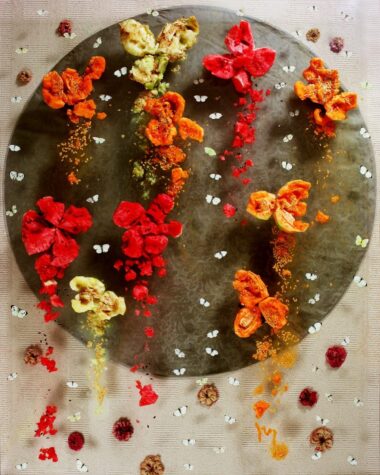
LC: Was he different from the way he painted?
A: Yes, I would never have known. I think he had different sides to him. He knew my family. He went to see my parents once. They lived in Monaco for seven years. He was invited to a dinner there and my father went up to him and said:
– “Yes, and who are you?”
– “I’m Francis Bacon.”
– “What do you do for a living?”
– “I paint.”
My father never knew but it was quite an interesting interaction. Bacon was very modest.
LC: Do you think that you’re also quite different from your work?
A: I’d like for people to see more of my work to know that. As for me, I don’t want to see my past work. I don’t think many artists want to. You look at it and think: Maybe I should have done this or that instead. It’s never perfect. There is no such thing as perfection!
LC: Is making art a choice?
A: To put it this way: I’m not good at anything else.
[Laughs]
And I also enjoy my work. Enjoy is the wrong word – I get satisfaction from doing it. I’m not good at making money. I’d be bored in a business.
I’m excited by visual things. There’s nothing better than being able to explain yourself, and I can explain myself with my art.
LC: In the past twenty years you haven’t done many sculptures. But when you initially went to an art school, you started with painting, then moved to sculpture. Why did you switch to sculpture at first, but now you’re not doing it anymore?
A: I found sculpture quite limited. I love colour. Painting is instant. Sculpture is blood, sweat and tears.
When you’re doing a portrait in sculpture, when you’re sculpting a face you go right in, you’re feeling around. And then you go back and you have to be very careful that you carry what you’ve seen back to the piece. It’s so different. But I chose paint.

